-
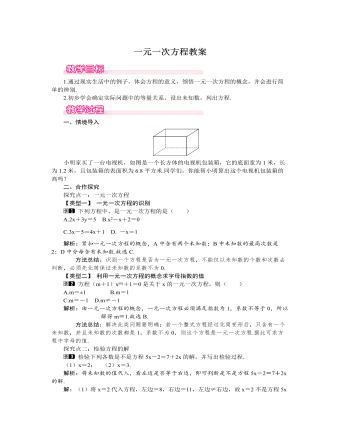
北师大初中七年级数学上册一元一次方程教案1
某文具店一支铅笔的售价为1.2元,一支圆珠笔的售价为2元.该店在“6·1儿童节”举行文具优惠售卖活动,铅笔按原价打8折出售,圆珠笔按原价打9折出售,结果两种笔共卖出60支,卖得金额87元.若设铅笔卖出x支,则依题意可列得的一元一次方程为( )A.1.2×0.8x+2×0.9(60+x)=87B.1.2×0.8x+2×0.9(60-x)=87C.2×0.9x+1.2×0.8(60+x)=87D.2×0.9x+1.2×0.8(60-x)=87解析:设铅笔卖出x支,根据“铅笔按原价打8折出售,圆珠笔按原价打9折出售,结果两种笔共卖出60支,卖得金额87元”,得出等量关系:x支铅笔的售价+(60-x)支圆珠笔的售价=87,据此列出方程为1.2×0.8x+2×0.9(60-x)=87.故选B.方法总结:解题的关键是读懂题意,设出未知数,找到题目当中的等量关系,最后列方程.三、板书设计教学过程中,通过对多种实际问题情境的分析,感受方程作为刻画现实世界有效模型的意义,通过观察、归纳一元一次方程的概念,使学生在分析实际问题情境的活动中体会数学与现实的密切联系.
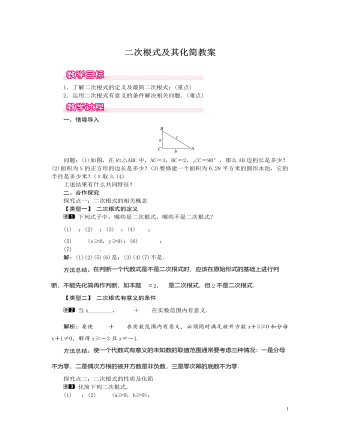
北师大初中数学八年级上册二次根式及其化简1教案
方法总结:(1)若被开方数中含有负因数,则应先化成正因数,如(3)题.(2)将二次根式尽量化简,使被开方数(式)中不含能开得尽方的因数(因式),即化为最简二次根式(后面学到).探究点三:最简二次根式在二次根式8a,c9,a2+b2,a2中,最简二次根式共有()A.1个 B.2个C.3个 D.4个解析:8a中有因数4;c9中有分母9;a3中有因式a2.故最简二次根式只有a2+b2.故选A.方法总结:只需检验被开方数是否还有分母,是否还有能开得尽方的因数或因式.三、板书设计二次根式定义形如a(a≥0)的式子有意义的条件:a≥0性质:(a)2=a(a≥0),a2=a(a≥0)最简二次根式本节经历从具体实例到一般规律的探究过程,运用类比的方法,得出实数运算律和运算法则,使学生清楚新旧知识的区别和联系,加深学生对运算法则的理解,能否根据问题的特点,选择合理、简便的算法,能否确认结果的合理性等等.
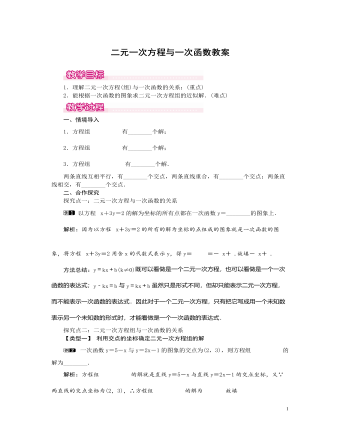
北师大初中数学八年级上册二元一次方程与一次函数1教案
由②得y=23x+23.在同一直角坐标系中分别作出一次函数y=3x-4和y=23x+23的图象.如右图,由图可知,它们的图象的交点坐标为(2,2).所以方程组3x-y=4,2x-3y=-2的解是x=2,y=2.方法总结:用画图象的方法可以直观地获得问题的结果,但不是很准确.三、板书设计1.二元一次方程组的解是对应的两条直线的交点坐标;2.用图象法解二元一次方程组的步骤:(1)变形:把两个方程化为一次函数的形式;(2)作图:在同一坐标系中作出两个函数的图象;(3)观察图象,找出交点的坐标;(4)写出方程组的解.通过引导学生自主学习探索,进一步揭示了二元一次方程和函数图象之间的对应关系,很自然的得到二元一次方程组的解与两条直线的交点之间的对应关系.进一步培养了学生数形结合的意识,充分提高学生数形结合的能力,使学生在自主探索中学会不同数学知识间可以互相转化的数学思想和方法.
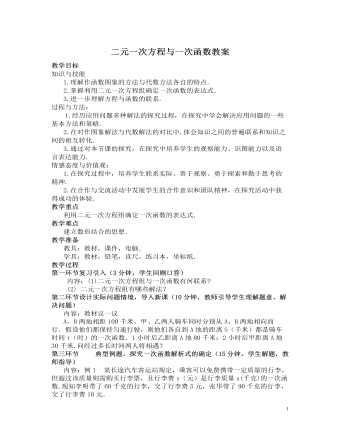
北师大初中数学八年级上册二元一次方程与一次函数2教案
2. 在弹性限度内,弹簧的长度y(厘米)是所挂物体质量x(千克)的一次函数.当所挂物体的质量为1千克时弹簧长15厘米;当所挂物体的质量为3千克时,弹簧长16厘米.写出y与x之间的函数关系式,并求当所挂物体的质量为4千克时弹簧的长度.答案: 当x=4是,y= 3. 教材例2的再探索:我边防局接到情报,近海处有一可疑船只A正向公海方向行驶.边防局迅速派出快艇B追赶,如图所示, , 分别表示两船相对于海岸的距离s(海里)与追赶时间t(分)之间的关系.当时间t等于多少分钟时,我边防快艇B能够追赶上A。答案:直线 的解析式: ,直线 的解析式: 15分钟第五环节课堂小结(2分钟,教师引导学生总结)内容:一、函数与方程之间的关系.二、在解决实际问题时从不同角度思考问题,就会得到不一样的方法,从而拓展自己的思维.三、掌握利用二元一次方程组求一次函数表达式的一般步骤:1.用含字母的系数设出一次函数的表达式: ;2.将已知条件代入上述表达式中得k,b的二元一次方程组;3.解这个二元一次方程组得k,b,进而得到一次函数的表达式.
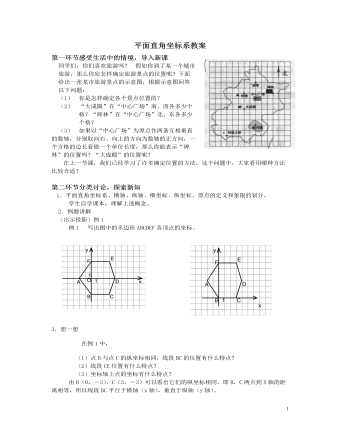
北师大初中数学八年级上册平面直角坐标系2教案
3.想一想在例1中,(1)点B与点C的纵坐标相同,线段BC的位置有什么特点?(2)线段CE位置有什么特点?(3)坐标轴上点的坐标有什么特点?由B(0,-3),C(3,-3)可以看出它们的纵坐标相同,即B,C两点到X轴的距离相等,所以线段BC平行于横轴(x轴),垂直于纵轴(y轴)。第三环节学有所用.补充:1.在下图中,确定A,B,C,D,E,F,G的坐标。(第1题) (第2题)2.如右图,求出A,B,C,D,E,F的坐标。第四环节感悟与收获1.认识并能画出平面直角坐标系。2.在给定的直角坐标系中,由点的位置写出它的坐标。3.能适当建立直角坐标系,写出直角坐标系中有关点的坐标。4.横(纵)坐标相同的点的直线平行于y轴,垂直于x轴;连接纵坐标相同的点的直线平行于x轴,垂直于y轴。5.坐标轴上点的纵坐标为0;纵坐标轴上点的坐标为0。6.各个象限内的点的坐标特征是:第一象限(+,+)第二象限(-,+),第三象限(-,-)第四象限(+,-)。
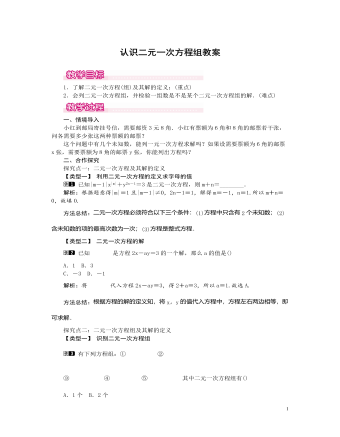
北师大初中数学八年级上册认识二元一次方程组1教案
小刘同学用10元钱购买两种不同的贺卡共8张,单价分别是1元与2元.设1元的贺卡为x张,2元的贺卡为y张,那么x,y所适合的一个方程组是()A.x+y2=10,x+y=8 B.x2+y10=8,x+2y=10C.x+y=10,x+2y=8 D.x+y=8,x+2y=10解析:根据题意可得到两个相等关系:(1)1元贺卡张数+2元贺卡张数=8(张);(2)1元贺卡钱数+2元贺卡钱数=10(元).设1元的贺卡为x张,2元的贺卡为y张,可列方程组为x+y=8,x+2y=10.故选D.方法总结:要判断哪个方程组符合题意,可从题目中找出两个相等关系,然后代入未知数,即可得到方程组,进而得到正确答案.三、板书设计二元一次方程组二元一次方程及其解的定义二元一次方程组及其解的定义列二元一次方程组通过自主探究和合作交流,建立二元一次方程的数学模型,学会逐步掌握基本的数学知识和方法,形成良好的数学思维习惯和应用意识,提高解决问题的能力,感受数学创造的乐趣,增进学好数学的信心,增加对数学较全面的体验和理解.
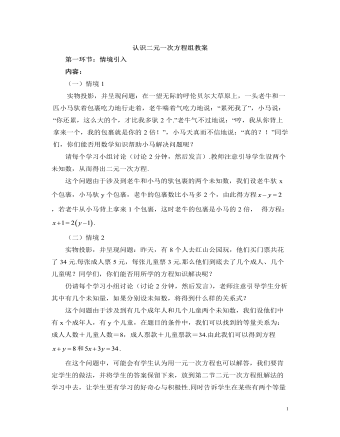
北师大初中数学八年级上册认识二元一次方程组2教案
第一环节:情境引入内容:(一) 情境1实物投影,并呈现问题:在一望无际的呼伦贝尔大草原上,一头老牛和一匹小马驮着包裹吃力地行走着,老牛喘着气吃力地说:“累死我了”,小马说:“你还累,这么大的个,才比我多驮2个.”老牛气不过地说:“哼,我从你背上拿来一个,我的包裹就是你的2倍!”,小马天真而不信地说:“真的?!”同学们,你们能否用数学知识帮助小马解决问题呢?请每个学习小组讨论(讨论2分钟,然后发言).教师注意引导学生设两个未知数,从而得出二元一次方程.这个问题由于涉及到老牛和小马的驮包裹的两个未知数,我们设老牛驮x个包裹,小马驮y个包裹,老牛的包裹数比小马多2个,由此得方程 ,若老牛从小马背上拿来1个包裹,这时老牛的包裹是小马的2倍, 得方程: .
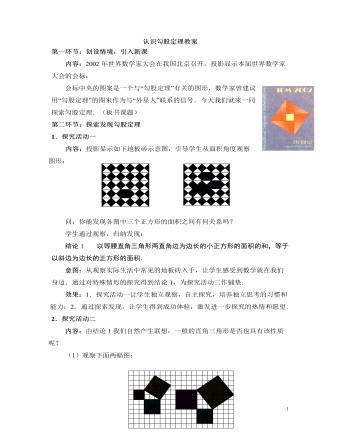
北师大初中数学八年级上册认识勾股定理2教案
意图:课后作业设计包括了三个层面:作业1是为了巩固基础知识而设计;作业2是为了扩展学生的知识面;作业3是为了拓广知识,进行课后探究而设计,通过此题可让学生进一步认识勾股定理的前提条件.效果:学生进一步加强对本课知识的理解和掌握.教学设计反思(一)设计理念依据“学生是学习的主体”这一理念,在探索勾股定理的整个过程中,本节课始终采用学生自主探索和与同伴合作交流相结合的方式进行主动学习.教师只在学生遇到困难时,进行引导或组织学生通过讨论来突破难点.(二)突出重点、突破难点的策略为了让学生在学习过程中自我发现勾股定理,本节课首先情景创设激发兴趣,再通过几个探究活动引导学生从探究等腰直角三角形这一特殊情形入手,自然过渡到探究一般直角三角形,学生通过观察图形,计算面积,分析数据,发现直角三角形三边的关系,进而得到勾股定理.
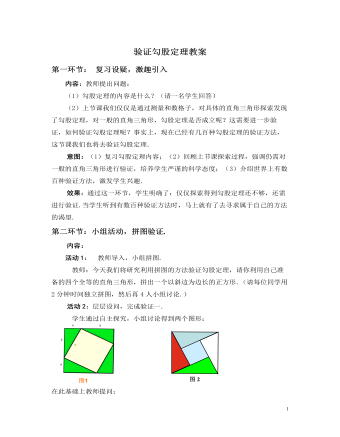
北师大初中数学八年级上册验证勾股定理2教案
意图:(1)介绍与勾股定理有关的历史,激发学生的爱国热情;(2)学生加强了对数学史的了解,培养学习数学的兴趣;(3)通过让部分学生搜集材料,展示材料,既让学生得到充分的锻炼,同时也活跃了课堂气氛.效果:学生热情高涨,对勾股定理的历史充满了浓厚的兴趣,同时也为中国古代数学的成就感到自豪.也有同学提出:当代中国数学成就不够强,还应发奋努力.有同学能意识这一点,这让我喜出望外.第六环节: 回顾反思 提炼升华内容:教师提问:通过这节课的学习,你有什么样的收获?师生共同畅谈收获.目的:(1)归纳出本节课的知识要点,数形结合的思想方法;(2)教师了解学生对本节课的感受并进行总结;(3)培养学生的归纳概括能力.效果:由于这节课自始至终都注意了调动学生学习的积极性,所以学生谈的收获很多,包括利用拼图验证勾股定理中蕴含的数形结合思想,学生对勾股定理的历史的感悟及对勾股定理应用的认识等等.
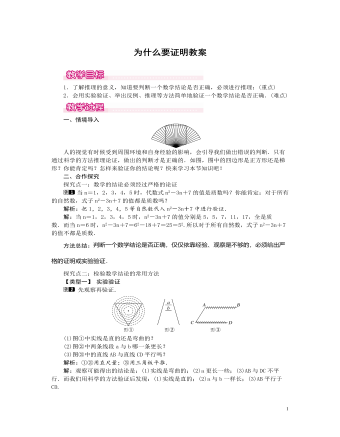
北师大初中数学八年级上册为什么要证明1教案
解析:图中∠AOB、∠COD均与∠BOC互余,根据角的和、差关系,可求得∠AOB与∠COD的度数.通过计算发现∠AOB=∠COD,于是可以归纳∠AOB=∠COD.解:(1)∵OA⊥OC,OB⊥OD,∴∠AOC=∠BOD=90°.∵∠BOC=30°,∴∠AOB=∠AOC-∠BOC=90°-30°=60°,∠COD=∠BOD-∠BOC=90°-30°=60°.(2)∠AOB=∠AOC-∠BOC=90°-54°=36°,∠COD=∠BOD-∠BOC=90°-54°=36°.(3)由(1)、(2)可发现:∠AOB=∠COD.(4)∵∠AOB+∠BOC=∠AOC=90°,∠BOC+∠COD=∠BOD=90°,∴∠AOB+∠BOC=∠BOC+∠COD.∴∠AOB=∠COD.方法总结:检验数学结论具体经历的过程是:观察、度量、实验→猜想归纳→结论→推理→正确结论.三、板书设计为什么,要证明)推理的意义:数学结论必须经过严格的论证检验数学结论的常用方法实验验证举出反例推理证明经历观察、验证、归纳等过程,使学生对由这些方法得到的结论产生怀疑,以此激发学生的好奇心,从而认识证明的必要性,培养学生的推理意识,了解检验数学结论的常用方法:实验验证、举出反例、推理论证等.
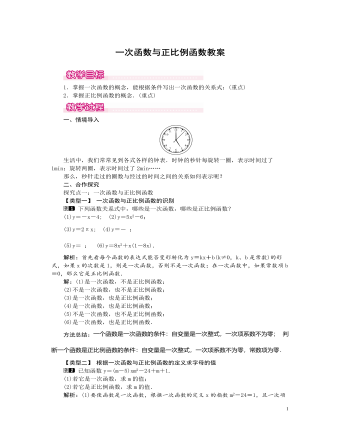
北师大初中数学八年级上册一次函数与正比例函数1教案
煤的价格为400元/吨,生产1吨甲产品除需原料费用外,还需其他费用400元,甲产品每吨售价4600元;生产1吨乙产品除原料费用外,还需其他费用500元,乙产品每吨售价5500元.现将该矿石原料全部用完,设生产甲产品x吨,乙产品m吨,公司获得的总利润为y元.(1)写出m与x的关系式;(2)写出y与x的函数关系式.(不要求写自变量的取值范围)解析:(1)因为矿石的总量一定,当生产的甲产品的数量x变化时,那么乙产品的产量m将随之变化,m和x是动态变化的两个量;(2)题目中的等量关系为总利润y=甲产品的利润+乙产品的利润.解:(1)因为4m+10x=300,所以m=150-5x2.(2)生产1吨甲产品获利为4600-10×200-4×400-400=600(元);生产1吨乙产品获利为5500-4×200-8×400-500=1000(元).所以y=600x+1000m.将m=150-5x2代入,得y=600x+1000×150-5x2,即y=-1900x+75000.方法总结:根据条件求一次函数的关系式时,要找准题中所给的等量关系,然后求解.
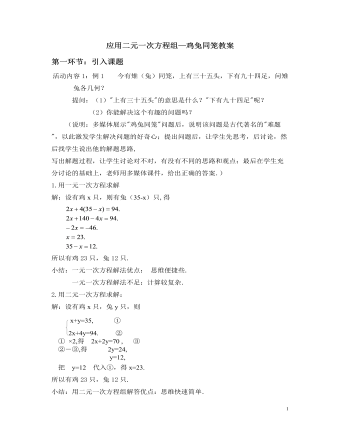
北师大初中数学八年级上册应用二元一次方程组——鸡兔同笼2教案
第三环节:课堂小结活动内容:1. 通过前面几个题,你对列方程组解决实际问题的方法和步骤掌握的怎样?2. 这里面应该注意的是什么?关键是什么?3. 通过今天的学习,你能不能解决求两个量的问题?(可以用二元一次方程组解决的。4. 列二元一次方程组解决实际问题的主要步骤是什么?说明:通过以上四个问题,学生基本上掌握了列二元一次方程组解决实际问题的方法和步骤,可启发学生说出自己的心得体会及疑问.活动意图:引导学生自己小结本节课的知识要点及数学方法,使知识系统化.说明:还可以建议有条件的学生去读一读《孙子算经》,可以在网上查,找出自己喜欢的问题,互相出题;同位的同学还可互相编题考察对方;还可以设置"我为老师出难题"活动,每人编一道题,给老师,老师再提出:"谁来帮我解难题",以此激发学生的学习兴趣和信心。
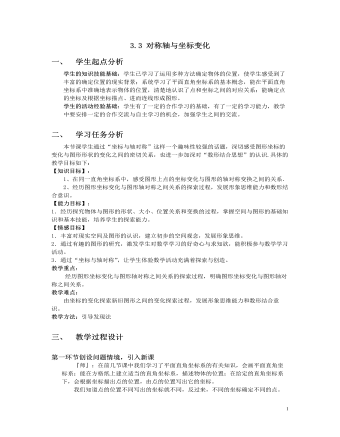
北师大初中数学八年级上册轴对称与坐标变化2教案
8.一束光线从点A(3,3)出发,经过y轴上点C反射后经过点B(1,0)则光线从A点到B点经过的路线长是( )A.4 B.5 C.6 D.7第四环节课堂小结1、关于y轴对称的两个图形上点的坐标特征:(x , y)——(- x , y)2、关于x轴对称的两个图形上点的坐标特征:(x , y)——(x , - y)3、关于原点对称的两个图形上点的坐标特征:(x , y)——(- x , -y)第五环节布置作业习题3.5 1,2,3四、 教学反思通过“坐标与轴对称”,经历图形坐标变化与图形的轴对称之间的关系的探索过程, 掌握空间与图形的基础知识和基本技能,丰富对现实空间及图形的认识,建立初步的空间观念,发展形象思维,激发学生对数学学习的好奇心与求知欲,学生能积极参与数学学习活动;积极交流合作,体验数学活动充满着探索与创造。教学中务必给学生创造自主学习与合作交流的机会,留给学生充足的动手机会和思考空间,教师不要急于下结论。事先一定要准备好坐标纸等,提高课堂效率。
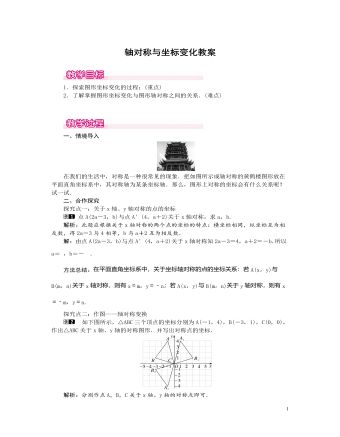
北师大初中数学八年级上册轴对称与坐标变化1教案
解析:从各点的位置可以发现A1(1,0),A2(1,1),A3(-1,1),A4(-1,-1),A5(2,-1),A6(2,2),A7(-2,2),A8(-2,-2),A9(3,-2),A10(3,3),A11(-3,3),A12(-3,-3),….仔细观察每四个点的横、纵坐标,发现存在着一定规律性.因为2015=503×4+3,所以点A2015在第二象限,纵坐标和横坐标互为相反数,所以A2015的坐标为(-504,504).故填(-504,504).方法总结:解决此类题常用的方法是通过对几种特殊情况的研究,归纳总结出一般规律,再根据一般规律探究特殊情况.三、板书设计轴对称与坐标变化关于坐标轴对称作图——轴对称变换通过本课时的学习,学生经历图形坐标变化与图形的轴对称之间的关系的探索过程,掌握空间与图形的基础知识和基本作图技能,丰富对现实空间及图形的认识,建立初步的空间观念,发展形象思维,激发数学学习的好奇心与求知欲.教学过程中学生能积极参与数学学习活动,积极交流合作,体验数学活动的乐趣.
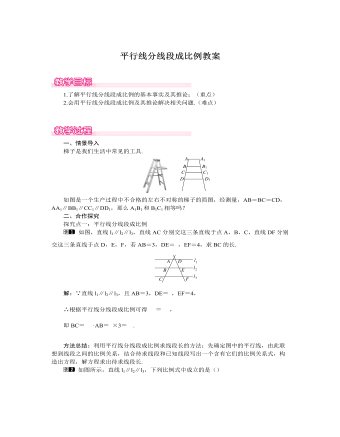
北师大初中数学九年级上册平行线分线段成比例1教案
证明:如图,过点C作CF∥PD交AB于点F,则BPCP=BDDF,ADDF=AECE.∵AD=AE,∴DF=CE,∴BPCP=BDCE.方法总结:证明四条线段成比例时,如果图形中有平行线,则可以直接应用平行线分线段成比例的基本事实以及推论得到相关比例式.如果图中没有平行线,则需构造辅助线创造平行条件,再应用平行线分线段成比例的基本事实及其推论得到相关比例式.三、板书设计平行线分线段成比例基本事实:两条直线被一组平行线所截, 所得的对应线段成比例推论:平行于三角形一边的直线与其他 两边相交,截得的对应线段成比例通过教学,培养学生的观察、分析、概括能力,了解特殊与一般的辩证关系.再次锻炼类比的数学思想,能把一个复杂的图形分成几个基本图形,通过应用锻炼识图能力和推理论证能力.在探索过程中,积累数学活动的经验,体验探索结论的方法和过程,发展学生的合情推理能力和有条理的说理表达能力.
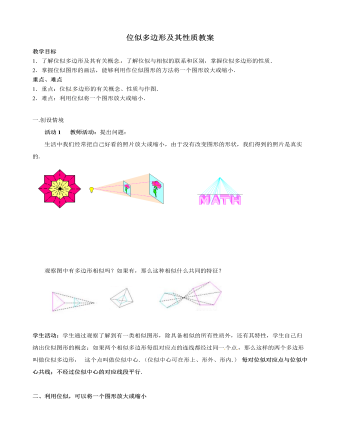
北师大初中数学九年级上册位似多边形及其性质2教案
(3)分别在射线OA,OB,OC,OD上取点A′、B′、C′、D′,使得 ;(4)顺次连接A ′B′、B′C′、C′D′、D′A′,得到所要画的四边形A′B′C′D′,如图2.问:此题目还可以 如何画出图形?作法二 :(1)在四边形ABCD外任取一点 O;(2)过点O分别作射线OA, OB, OC,OD;(3)分别在射线OA, OB, OC, OD的反向延长线上取点A′、B′、C′、D′,使得 ;(4)顺次连接A ′B′、B′ C′、C′D′、D′A′,得到所 要画的四边形A′B′C′D′,如图3. 作法三:(1)在四边形ABCD内任取一点O;(2)过点O分别作 射线OA,OB,OC,OD;(3)分别在射线OA,OB,OC,OD上取点A′、B′、C′、D′,使得 ;(4)顺次连接A′B′、B′C ′、C′D′、D′A′,得到所要画的四边形A′B′C′D′,如图4.(当点O在四边形ABCD的一条边上或在四边形ABCD的一个顶点上时,作法略——可以让学生自己完成)三、课堂练习 活动3 教材习题小结:谈谈你这节课学习的收获.

北师大初中数学九年级上册位似多边形及其性质1教案
①分别连接OA,OB,OC,OD,OE;②分别在AO,BO,CO,DO,OE上截取OA′,OB′,OC′,OD′,OE′,使OA′OA=OB′OB=OC′OC=OD′OD=OE′OE=13;③顺次连接A′B′,B′C′,C′D′,D′E′,E′A′.五边形A′B′C′D′E′就是所求作的五边形;(3)画法如下:①分别连接AO,BO,CO,DO,EO,FO并延长;②分别在AO,BO,CO,DO,EO,FO的延长线上截取OA′,OB′,OC′,OD′,OE′,OF′,使OA′OA=OB′OB=OC′OC=OD′OD=OE′OE=OF′OF=12;③顺次连接A′B′,B′C′,C′D′,D′E′,E′F′,F′A′.六边形A′B′C′D′E′F′就是所求作的六边形.方法总结:(1)画位似图形时,要注意相似比,即分清楚是已知原图与新图的相似比,还是新图与原图的相似比.(2)画位似图形的关键是画出图形中顶点的对应点.画图的方法大致有两种:一是每对对应点都在位似中心的同侧;二是每对对应点都在位似中心的两侧.(3)若没有指定位似中心的位置,则画图时位似中心的取法有多种,对画图而言,以多边形的一个顶点为位似中心时,画图最简便.三、板书设计
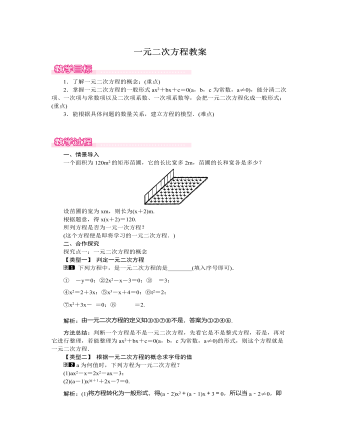
北师大初中数学九年级上册一元二次方程1教案
解:设需要剪去的小正方形边长为xcm,则纸盒底面的长方形的长为(19-2x)cm,宽为(15-2x)cm.根据题意,得(19-2x)(15-2x)=81.整理,得x2-17x+51=0(x<152).方法总结:列方程最重要的是审题,只有理解题意,才能恰当地设出未知数,准确地找出已知量和未知量之间的等量关系,正确地列出方程.在列出方程后,还应根据实际需求,注明自变量的取值范围.三、板书设计一元二次方程概念:只含有一个未知数x的整式方 程,并且都可以化成ax2+bx+c =0(a,b,c为常数,a≠0)的形式一般形式:ax2+bx+c=0(a,b,c为常 数,a≠0),其中ax2,bx,c 分别称为二次项、一次项和 常数项,a,b分别称为二次 项系数和一次项系数本课通过丰富的实例,让学生观察、归纳出一元二次方程的有关概念,并从中体会方程的模型思想.通过本节课的学习,应该让学生进一步体会一元二次方程也是刻画现实世界的一个有效数学模型,初步培养学生的数学来源于实践又反过来作用于实践的辩证唯物主义观点,激发学生学习数学的兴趣.

北师大初中数学九年级上册用公式法求解一元二次方程1教案
∴(-2m a)2-4(b+c)(c-b)m=0,即4m(a2+b2-c2)=0.又∵m≠0,∴a2+b2-c2=0,即a2+b2=c2.根据勾股定理的逆定理可知△ABC为直角三角形.方法总结:根据一元二次方程根的情况,利用判别式得到关于一元二次方程系数的等式或不等式,再结合其他条件解题.三、板书设计用公式法解一元二次方程求根公式:x=-b±b2-4ac2a(a≠0,b2-4ac≥0)用公式法解一元二次 方程的一般步骤①化为一般形式②确定a,b,c的值③求出b2-4ac④利用求根公式求解一元二次方程根的判别式经历从用配方法解数字系数的一元二次方程到解字母系数的一元二次方程,探索求根公式,发展学生合情合理的推理能力,并认识到配方法是理解求根公式的基础.通过对求根公式的推导,认识到一元二次方程的求根公式适用于所有的一元二次方程,操作简单.体会数式通性,感受数学的严谨性和数学结论的确定性.提高学生的运算能力,并养成良好的运算习惯.
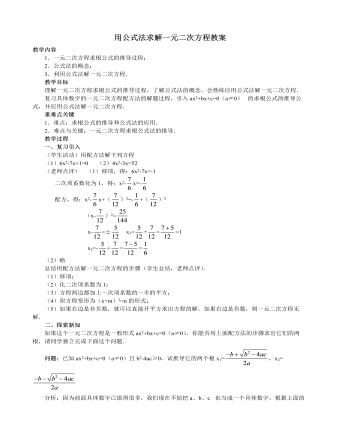
北师大初中数学九年级上册用公式法求解一元二次方程2教案
二、填空题1.一元二次方程ax2+bx+c=0(a≠0)的求根公式是________,条件是________.2.当x=______时,代数式x2-8x+12的值是-4.3.若关于x的一元二次方程(m-1)x2+x+m2+2m-3=0有一根为0,则m的值是_____.三、综合提高题1.用公式法解关于x的方程:x2-2ax-b2+a2=0.2.设x1,x2是一元二次方程ax2+bx+c=0(a≠0)的两根,(1)试推导x1+x2=- ,x1·x2= ;(2)求代数式a(x13+x23)+b(x12+x22)+c(x1+x2)的值.3.某电厂规定:该厂家属区的每户居民一个月用电量不超过A千瓦时,那么这户居民这个月只交10元电费,如果超过A千瓦时,那么这个月除了交10元用电费外超过部分还要按每千瓦时 元收费.(1)若某户2月份用电90千瓦时,超过规定A千瓦时,则超过部分电费为多少元?(用A表示)(2)下表是这户居民3月、4月的用电情况和交费情况